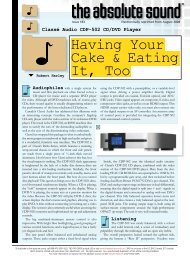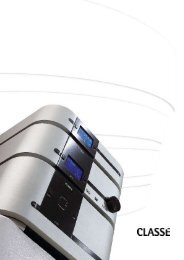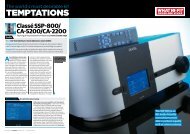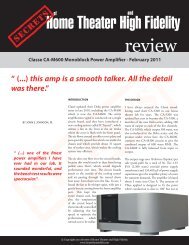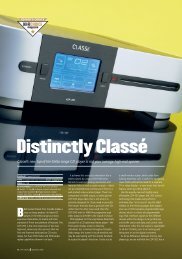Owner's Manual CT-M600 Power Amplifier - Classé Audio
Owner's Manual CT-M600 Power Amplifier - Classé Audio
Owner's Manual CT-M600 Power Amplifier - Classé Audio
Create successful ePaper yourself
Turn your PDF publications into a flip-book with our unique Google optimized e-Paper software.
Owner’s <strong>Manual</strong><br />
<strong>CT</strong>-<strong>M600</strong><br />
<strong>Power</strong> <strong>Amplifier</strong>
NOTICE<br />
All of us at Classé take extreme care to ensure that your purchase will remain a prized investment. We are proud to inform you<br />
that all Classé components have been officially approved for the European Community (CE) mark.<br />
This means that your Classé product was subjected to the most rigorous manufacturing and safety tests in the world. The CE<br />
mark certifies that your purchase meets or exceeds all European Community requirements for manufacturing consistency and<br />
consumer safety.<br />
This equipment has been tested and found to comply with the limits for a Class B digital device, pursuant to Part 15 of the<br />
FCC Rules. Operation is subject to the following two conditions: (1) This device may not cause harmful interference, and (2)<br />
This device must accept any interference received, including interference that may cause undesired operation. These limits are<br />
designed to provide reasonable protection against harmful interference in a residential installation. This equipment generates,<br />
uses and can radiate radio frequency energy and, if not installed and used in accordance with the instructions, may cause<br />
harmful interference to radio communications. However, there is no guarantee that interference will not occur in a particular<br />
installation. If this equipment does cause interference to radio or television reception, which can be determined by turning the<br />
equipment on and off, the user is encouraged to try to correct the interference by one or more of the following measures:<br />
• Reorient or relocate the receiving antenna;<br />
• Increase the separation between the equipment and the receiver;<br />
• Connect the equipment into an outlet on a circuit different from that to which the receiver is connected;<br />
• Consult the dealer or an experienced radio/TV technician for help.<br />
CAUTION: Changes or modifications to this equipment not expressly approved by the manufacturer could void the user’s<br />
authority to operate the equipment.<br />
This product incorporates copyright protection technology that is protected by U.S. patents ad other intellectual property<br />
rights. Use of this copyright protection technology must be authorized by Macrovision, and is intended for home and other<br />
limited viewing uses otherwise authorized by Macrovision. Reverse engineering or disassembly is prohibited.<br />
The information contained in the manual is subject to change without notice. The most current version of this manual will be<br />
posted on our web site at http://www.classeaudio.com.<br />
Classé marks the “CE” symbol indicating compliance of this device with the EMC (Electromagnetic<br />
Compatibility) and LVD (Low Voltage Directive) standards of the European Community.<br />
Classé complies with the European Parliament and Council Directive 2002/96/EC concerning Waste Electrical<br />
and Electronic Equipment (WEEE). This product must be appropriately recycled or processed in accordance with<br />
these directives. Consult your local waste disposal authority for guidance.<br />
Classé products are designed and manufactured to comply with the Restriction of Hazardous Substances (RoHS)<br />
as stated in the European Parliament and Council Directive 2002/95/EC.<br />
2
Important Safety Instructions<br />
1. Read these instructions.<br />
2. Keep these instructions.<br />
3. Heed all warnings.<br />
4. Follow all instructions.<br />
5. Do not use this apparatus near water.<br />
6. Clean only with dry cloth.<br />
7. Do not block any ventilation openings. Install in accordance with the manufacturer’s instructions.<br />
8. Do not install near any heat sources such as radiators, heat registers, stoves, or other apparatus that produce<br />
heat.<br />
9. Do not defeat the safety purpose of the polarized or grounding-type plug. A polarized plug has two blades<br />
with one wider than the other. A grounding type plug has two blades and a third grounding prong. The<br />
wide blade or the third prong are provided for your safety. If the provided plug does not fit into your outlet,<br />
consult an electrician for replacement of the obsolete outlet.<br />
10. Protect the power cord from being walked on or pinched particularly at plugs, convenience receptacles, and<br />
the point where they exit from the apparatus.<br />
11. Only use attachments/accessories specified by the manufacturer.<br />
12. Use only with the cart, stand, tripod, bracket, or table specified by the manufacturer, or sold with<br />
the apparatus. When a cart is used, use caution when moving the cart/apparatus combination to avoid injury<br />
from tip-over.<br />
13. Unplug this apparatus during lightning storms or when unused for long periods of time.<br />
14. Refer all servicing to qualified service personnel. Servicing is required when the apparatus has been damaged<br />
in any way, such as power-supply cord or plug is damaged, liquid has been spilled or objects have fallen into<br />
the apparatus, the apparatus has been exposed to rain or moisture, does not operate normally, or has been<br />
dropped.<br />
15. Do not expose this apparatus to dripping or splashing and ensure that no objects filled with liquids, such as<br />
vases, are placed on the apparatus.<br />
WARNING: TO REDUCE THE RISK OF FIRE OR ELE<strong>CT</strong>RIC SHOCK,<br />
DO NOT EXPOSE THIS APPLIANCE TO RAIN OR MOISTURE.<br />
CAUTION<br />
RISK OF ELE<strong>CT</strong>RIC SHOCK<br />
DO NOT OPEN<br />
CAUTION: TO REDUCE THE RISK OF ELE<strong>CT</strong>RICAL SHOCK, DO NOT<br />
REMOVE COVER. NO USER-SERVICEABLE PARTS INSIDE. REFER<br />
SERVICING TO QUALIFIED PERSONNEL.<br />
The lightning flash with arrowhead symbol within an equilateral triangle is intended to alert the user<br />
to the presence of uninsulated “dangerous voltage “ within the product’s enclosure that may be of sufficient<br />
magnitude to constitute a risk of electric shock to persons.<br />
The exclamation point within an equilateral triangle is intended to alert the user to the presence of important<br />
operating and maintenance (servicing) instructions in the literature accompanying the product.<br />
3
Contents<br />
Welcome to the Classé family ........................................................................... 5<br />
a word about installation ............................................................................ 5<br />
Unpacking and Placement ................................................................................ 6<br />
unpacking your amplifier ........................................................................... 6<br />
placement .................................................................................................. 6<br />
ventilation .................................................................................................. 6<br />
custom installations .................................................................................... 6<br />
serial number ............................................................................................. 6<br />
operating voltage ........................................................................................ 7<br />
warm up/break-in period ............................................................................ 8<br />
please read this manual .............................................................................. 8<br />
Special Design Features .................................................................................... 9<br />
highly refined circuit design… .................................................................... 9<br />
extensive listening tests ............................................................................... 9<br />
extraordinary longevity ............................................................................... 9<br />
robust protection ...................................................................................... 10<br />
Front Panel ...................................................................................................... 11<br />
Rear Panel ....................................................................................................... 13<br />
Installation ...................................................................................................... 17<br />
CAN-Bus ...................................................................................................... 20<br />
features ..................................................................................................... 20<br />
hardware setup ......................................................................................... 20<br />
using CAN-Bus ......................................................................................... 22<br />
CAN-Bus shared features ............................................................................. 23<br />
configuration ............................................................................................ 23<br />
operate ..................................................................................................... 23<br />
AC status .................................................................................................. 23<br />
status ........................................................................................................ 23<br />
name ........................................................................................................ 23<br />
global brightness ...................................................................................... 23<br />
global standby .......................................................................................... 23<br />
CAN-Bus model specific features ................................................................. 24<br />
PlayLink ................................................................................................... 24<br />
amp info ................................................................................................... 25<br />
event log .................................................................................................. 25<br />
Care and Maintenance .................................................................................... 26<br />
Troubleshooting .............................................................................................. 27<br />
Specifications .................................................................................................. 29<br />
Dimensions ..................................................................................................... 30<br />
4
Welcome to the Classé family<br />
Congratulations on your purchase of a Classé product. It is the result of many<br />
years of continuous refinement, and we are sure that you will enjoy it for many<br />
years to come.<br />
We value our relationship with our customers. Please allow us to stay in touch<br />
with you by returning your warranty card now, before you pack up the shipping<br />
carton of your new product and forget all about it. Doing so will enable us to<br />
let you know about any possible future upgrades or updates that might become<br />
available for your Classé component.<br />
You can register online at www.classeaudio.com or complete and mail the<br />
registration card located in the separate warranty booklet.<br />
Please take a few moments now to register your new<br />
Classé processor and record your serial number here for<br />
future reference.<br />
Serial #: _________________________________________<br />
a word about installation<br />
Every effort has been made to make the Classé <strong>CT</strong>-<strong>M600</strong> simple and<br />
straightforward to install and use.<br />
It has been designed specifically for rack mount installations, although it may<br />
just as easily be placed on a shelf, in a traditional cabinet or on the floor near<br />
the speaker(s). The size and shape of your room, its acoustics, and the associated<br />
equipment you have chosen to use with your amplifier all influence the ultimate<br />
performance of your system.<br />
For this reason, we strongly encourage you to have your<br />
system installed and calibrated by your dealer, whose<br />
experience, training, and specialized equipment can<br />
make a profound difference in the final performance of<br />
the system.<br />
5
Unpacking and Placement<br />
unpacking your amplifier<br />
Carefully unpack your power amplifier according to the supplied instructions,<br />
and remove all accessories from the carton. Please take care when lifting the<br />
amplifier, as it is quite heavy.<br />
Important!<br />
Keep all packing materials for future transport of your<br />
Classé product. Shipping your new component in anything<br />
other than its purpose-designed packing material may<br />
result in damage that is not covered by the warranty.<br />
placement<br />
Most installations will likely utilize an equipment rack, although a shelf, a<br />
traditional cabinet or the floor near the speaker(s) are acceptable alternatives. In<br />
any case, take care to position it well away from source components and preamp/<br />
processors, which may be sensitive to the amplifier’s electromagnetic fields.<br />
Note that adequate clearance for the AC cord and connecting cables<br />
must be left behind the amplifier. We suggest leaving six inches (15 cm)<br />
of free space behind your power amplifier to allow all cables sufficient<br />
room to bend without crimping or undue strain.<br />
ventilation<br />
Your Classé power amplifier generates a certain amount of heat in the course<br />
of normal operation. The vents on both the bottom and the top of the<br />
amplifier must be kept free from any obstruction which would reduce the flow<br />
of air through the unit. Avoid placement on soft surfaces that would restrict<br />
airflow (such as plush carpeting).<br />
custom installations<br />
Drawings are included in this manual to facilitate special installations and<br />
custom cabinetry (see the section Dimensions). A purpose-designed rack<br />
mount kit is included with this product. Contact your Classé dealer for more<br />
information.<br />
serial number<br />
The serial number for your power amplifier is found on the rear of the unit.<br />
Please note and record this number on the page entitled Important Safety<br />
Instructions for your future reference.<br />
6
operating voltage<br />
The amplifier is set at the factory (internally) for 100V, 120V, 220V, 230V, or<br />
240V AC mains operation, as appropriate for the country in which it is to be<br />
sold (230V only in European Union countries, in compliance with CE regulations).<br />
The voltage setting may not be changed by the user or dealer.<br />
Make sure that the label on the rear panel of your power amplifier indicates<br />
the correct AC operating voltage for your location. Attempting to operate your<br />
power amplifier at an incorrect voltage may damage the unit.<br />
Warning:<br />
The voltage setting of your power amplifier may not be<br />
changed by the user. There are no user-serviceable parts<br />
within the unit. Please refer any problems to an authorized<br />
Classé service center.<br />
If the AC mains voltage indicated on your power amplifier is incorrect, please<br />
contact your local, authorized Classé dealer or distributor.<br />
The amplifier can easily be powered by a normal 15 or 20-ampere AC mains<br />
line. If other devices are also powered from the same AC line, their additional<br />
power consumption should be taken into account.<br />
The amplifier includes protection circuitry that will prevent the amplifier from<br />
operating at dangerously high or low voltages.<br />
• At startup: the AC mains voltage must be within a range of<br />
approximately -15% to +10% of its nominal value at startup, or<br />
the amplifier will not turn on. For example, a 120V unit requires<br />
the AC mains to be between approximately 95V–135V in order to<br />
turn on.<br />
• Over-voltage during operation: if the AC mains voltage surges<br />
by roughly 10% or more during operation, the amplifier will enter<br />
protection mode and shut down. The Standby LED will flash to<br />
indicate the protection mode has been engaged.<br />
• Under-voltage during operation: if the AC mains voltage sags by<br />
15% or more, the amplifier will continue to play (since this does<br />
not present a particular danger to the amplifier), but note that<br />
it may not be able to achieve its usual standard of performance<br />
under these compromised conditions. The Standby LED will flash<br />
to indicate the condition.<br />
7
warm up/break-in period<br />
Your new Classé power amplifier will deliver outstanding performance<br />
immediately. However, you should expect to hear it improve somewhat as<br />
it reaches its normal operating temperatures and its various components<br />
“break-in.” It has been our experience that the greatest changes occur within the<br />
first 300 hours, as the amplifier reaches thermal equilibrium and the capacitors<br />
fully form. After this initial break-in period, the performance of your new<br />
product should remain quite consistent for years to come.<br />
The only exception to this rule is if the unit is placed in standby or unplugged<br />
for an extended period of time, allowing it to cool down. Depending on the<br />
degree of cooling involved, you should expect a brief warm-up period before the<br />
power amplifier’s sound quality is at its best. Unless your amplifier was allowed<br />
to become quite chilled, subsequent thermal re-stabilization should not take<br />
long. Fortunately, you should never have to repeat the initial 300 hour break-in<br />
period.<br />
please read this manual…<br />
Please take a few minutes to review this manual, and to familiarize yourself with<br />
your new amplifier. We understand that you are anxious to plug everything in<br />
and get started. However, reading this manual and following the advice it gives<br />
will ensure that you get all the benefits you deserve from having purchased such<br />
a fine piece of equipment.<br />
8
Special Design Features<br />
highly refined<br />
circuit design<br />
All Classé analog amplification stages are based on circuits that have been<br />
extensively optimized over many years of continuous development.<br />
By starting with excellent circuit designs and working with them over the years,<br />
we are able to discover the many small refinements that add up to superlative<br />
performance, in a variety of applications. Refining the circuit board layout,<br />
altering a voltage here, or using a slightly different part there, may make all the<br />
difference between solid and absolutely outstanding performance.<br />
This level of refinement only comes with a great deal of experience, and is not<br />
available to those who flit from one trendy notion to the next. It accounts<br />
in no small measure for both the consistency of sonic performance among<br />
Classé products (as they are all based on similar analog gain stages), and for the<br />
consistently excellent reviews those products receive by owners and reviewers<br />
alike.<br />
extensive listening tests<br />
Excellent measured performance is to be expected in world-class products, and<br />
Classé products deliver that performance. However, experience has shown that<br />
technical excellence alone is insufficient to guarantee subjectively musical results.<br />
For this reason, all Classé products are laboriously fine-tuned during the<br />
development process by carefully controlled listening tests. Our ears are still<br />
some of the finest laboratory test instruments available, and nicely complement<br />
more traditional engineering test equipment. We rely on careful listening tests,<br />
which we view as a necessary complement to the solid engineering you might<br />
rightly expect from Classé.<br />
extraordinary longevity<br />
Another benefit of having worked with highly refined circuit designs so<br />
extensively over many years is that we have vast experience in what works well<br />
over the long term.<br />
By using only the highest quality parts to begin with, and then using them in an<br />
informed way as a result of both accelerated aging experiments and actual longterm<br />
experience, we are able to design and manufacture products which we are<br />
confident will stand the test of time.<br />
We are confident that your new Classé product will give you many years of<br />
trouble-free reliability and musical enjoyment, just as previous Classé products<br />
have given their owners.<br />
9
obust protection<br />
Finally, your new Classé amplifier incorporates a variety of protection circuits, all<br />
designed to protect both the amplifier and your loudspeakers against dangerous<br />
fault conditions. Significantly, these protection circuits do not intrude upon<br />
or limit the normal performance of the amplifier; rather, they simply put the<br />
amplifier into protection mode when confronted with abnormal conditions.<br />
These conditions include:<br />
• output overload<br />
• DC offset<br />
• AC mains voltage (outside of normal tolerances)<br />
• excessive operating temperatures<br />
If any such conditions occur (any of which might harm either your amplifier or<br />
possibly your loudspeakers), the amplifier will immediately go into protection<br />
mode. In such a case, a Standby LED indicator will blink red until the fault can<br />
be righted and the amplifier is re-started by pressing and holding the standby<br />
button.<br />
Likewise, if the AC mains voltage is out of range, the Standby LED will<br />
blink. In all cases, the unit will need to be re-started once the cause of the fault<br />
condition has been rectified.<br />
10
<strong>CT</strong>-<strong>M600</strong><br />
Front Panel<br />
1 Standby button & LED indicator<br />
The front panel Standby button will toggle the amplifier between operate,<br />
its fully operational state, and a standby mode that leaves the amplifier off,<br />
yet ready to respond to system commands via any of the supported control<br />
options (e.g. IR input, DC trigger, CAN-Bus, or RS-232).<br />
The current state of the amplifier is indicated by the LED indicator in the<br />
Standby button. The state of this LED indicates the following:<br />
• on (dim red) = standby<br />
• flashing blue (on power-up) = initialization<br />
• on (blue) = operate<br />
• flashing (after power-up) = AC mains voltage out of range<br />
• flashing (alternating red/blue) = the air intake filter needs to be cleaned<br />
• slow flashing red = protection circuit(s) engaged<br />
When in standby, the amplifier’s gain stages are powered down. Only a<br />
small power supply and control circuit remain on, consuming relatively<br />
little power. Fortunately, since the output stages by their nature conduct a<br />
great deal of current, they warm up and sound their best very quickly.<br />
If you are not going to use the amplifier for an extended period of time,<br />
perhaps while traveling for a vacation, we suggest you disconnect it from<br />
the AC mains. Please be certain that the amplifier is in standby prior to<br />
disconnecting it from the AC mains.<br />
11
Also, it is a good practice to physically disconnect any and all valuable<br />
electronics from the AC mains during electrical storms, as a lightning<br />
strike anywhere near your home can put a tremendous surge on the AC<br />
mains that can easily damage any piece of electronics, no matter how well<br />
designed and protected. The best protection in the case of severe electrical<br />
storms is to simply remove the electronics from any connection with the<br />
power grid.<br />
Caution!<br />
If you see the Standaby LED indicator blinking red,<br />
please disconnect the amplifier from the AC mains<br />
immediately and check that all external connections<br />
are cleanly made and secure. If no fault is immediately<br />
obvious, please call your authorized Classé dealer for<br />
assistance.<br />
12
4<br />
10 9 3<br />
2<br />
1<br />
OUTPUT<br />
OUT<br />
CAN BUS<br />
7<br />
IN<br />
100-120~<br />
220-240~<br />
CLASS 2 WIRING<br />
8<br />
RS 232<br />
SHOCK HAZARD - DO NOT OPEN<br />
RISQUE DE CHOC ÉLE<strong>CT</strong>RIQUE-NE PAS OUVRIR<br />
CAUTION! TO REDUCE THE RISK OF ELE<strong>CT</strong>RIC SHOCK, GROUNDING<br />
OF THE CENTER PIN OF THIS PLUG MUST BE MAINTAINED<br />
AVIS! POUR RÉDUIRE LE RISQUE DE CHOC ÉLE<strong>CT</strong>RIQUE<br />
LA FICHE CENTRALE DE LA PRISE DOIT ÊTRE<br />
BRANCHÉE POUR MAINTENIR LA MISE À LA TERRE<br />
INPUT<br />
6<br />
USB<br />
OUT<br />
TRIGGER<br />
IN<br />
THIS DEVICE COMPLIES WITH PART 15 OF THE FCC RULES.<br />
OPERATION IS SUBJE<strong>CT</strong> TO THE FOLLOWING TWO CONDITIONS:<br />
(1) THIS DEVICE MAY NOT CAUSE HARMFUL INTERFERENCE, AND<br />
(2) THIS DEVICE MUST ACCEPT ANY INTERFERENCE RECEIVED,<br />
INCLUDING INTERFERENCE THAT MAY CAUSE UNDESIRED OPERATION.<br />
5<br />
OUT<br />
IR<br />
IN<br />
Rear Panel<br />
The following descriptions are intended as a quick reference, should you have<br />
any questions about your new product. Please see the next section (entitled<br />
Initial Setup) for specific advice on incorporating your new amplifier into your<br />
system.<br />
1 Balanced (XLR) Input<br />
Balanced audio interconnections were originally developed for the<br />
telephone and more recently in the professional audio world, for preserving<br />
the delicate nuances of extremely small microphone-level signals. For many<br />
years now, they have also been used by performance-oriented companies<br />
such as Classé to preserve every nuance of the finest audio performances in<br />
your collection.<br />
Technically, balanced audio interconnections provide two distinct benefits:<br />
they double the signal’s strength as it travels from one component to the<br />
next, increasing the potential signal to noise ratio by 6 dB; they also do an<br />
excellent job of rejecting noise and interference that might otherwise be<br />
picked up between the components, due to either EMI (electromagnetic<br />
interference) or RFI (radio frequency interference). In the world of wireless<br />
telecommunications, there is more potential interference around than ever<br />
before—it makes sense to keep it out of music and movie soundtracks.<br />
For this reason, we strongly recommend using the balanced analog<br />
interconnections between your Classé components wherever possible.<br />
The pin assignments of these XLR input connectors are:<br />
Pin 1: Signal ground<br />
Pin 2: Signal + (non-inverting)<br />
Pin 3: Signal – (inverting)<br />
Connector ground lug: chassis ground<br />
13
These pin assignments are consistent with the standard adopted by the<br />
<strong>Audio</strong> Engineering Society (AES14-1992).<br />
If you are using your Classé power amplifier with a Classé preamplifier/<br />
processor, you’re all set – just remove the supplied shorting pins from the<br />
amplifier’s XLR connector(s), take standard balanced interconnect cables<br />
and plug them in.<br />
If you are using another brand of preamplifier or processor, please refer to its<br />
operating manual to verify that the pin assignments of its output connectors<br />
correspond to those of your amplifier. If not, have your dealer wire the cables<br />
so that the appropriate output pin connects to the equivalent input pin.<br />
2 Single-Ended (RCA) Input<br />
Single-ended cables using RCA connectors are the most common form<br />
of analog connection used in consumer electronics. When implemented<br />
carefully and with use of high quality interconnecting cables, this standard<br />
can provide excellent performance. Classé has gone to extraordinary effort<br />
to ensure that the single-ended (RCA) input of your power amplifier is<br />
as good as possible. However, this connection standard cannot offer the<br />
immunity from interference that balanced interconnection does—hence<br />
our recommendation to use the balanced inputs when possible.<br />
3 Speaker Outputs<br />
Two pairs of high quality five-way binding posts are provided on the<br />
amplifier, in order to facilitate bi-wiring.<br />
In practice, bi-wiring involves connecting two (preferably identical) sets<br />
of speaker cables between each amplifier channel and its corresponding<br />
loudspeaker. In many cases, the benefit is a subjectively improved level of<br />
clarity and detail from the speaker, as a result of being able to feed the two<br />
separate sections of its crossover and driver complement with identical, yet<br />
separate signals.<br />
(Many high quality loudspeakers also offer two sets of connections on their<br />
speakers. Generally, one set of the connections on the loudspeaker feeds the<br />
portion of the speaker’s crossover network that supplies the woofer with its<br />
signal; the other set of connections connects to the portion of the crossover that<br />
supplies the rest of the speaker with the midrange and high frequencies.)<br />
Although the binding posts on your Classé amplifier will accept bare wire<br />
connections, we strongly recommend the use of high quality spade or hook<br />
lugs, crimped and soldered onto the ends of your speaker wires. Using<br />
high quality connectors will ensure that your speaker connections do not<br />
gradually deteriorate from fraying and oxidizing bare wires. It also helps<br />
prevent accidental short-circuits from poorly-terminated connections.<br />
4 Classé CAN-Bus Control Ports<br />
These RJ-45 connectors are reserved for control and communication<br />
applications using Classé <strong>Audio</strong>’s implementation of the Controller Area<br />
Network (CAN) Bus specification. Refer to the CAN-Bus section located<br />
later in this manual for more information.<br />
14
5 IR Input and Output<br />
Your Classé amplifier includes two 1 /8 th -inch mini mono-jacks in order to<br />
support the IR remote controls that are ubiquitous today. IR commands<br />
exist for toggling the amplifier between operate and standby, as well as<br />
discrete command codes for either operate or standby. These codes may be<br />
used in “macros” for sophisticated remote control systems, facilitating the<br />
control of the amplifier in the larger context of a complete system.<br />
Actually, this IR Input and Output description is a bit of a misnomer: the<br />
input supplied to these plugs is electrical in nature, not IR. It is obtained by<br />
using standard IR receivers, distribution amplifiers, and emitters (available<br />
from your dealer) to translate the remote’s flashes of infrared light into<br />
corresponding pulses of electricity. The big advantages here include being<br />
able to easily route the signals anywhere they might need to go, and the<br />
reliability of a solid electrical connection.<br />
Since an IR distribution system such as your dealer may design for you<br />
usually must control many products, your amplifier includes both an IR<br />
input (for the control of this product) and an IR output (so as to pass<br />
along the same signal to the next product). This allows you to “daisy chain”<br />
your control wires from one product to the next.<br />
The amplifier is designed to respond to IR commands of 5 Volts DC, with<br />
the tip of the mini-plugs defined to be “positive” relative to the shank of<br />
the plug.<br />
6 DC Trigger Input and Output<br />
Many audio/video preamplifiers can supply a DC control voltage to<br />
associated equipment in order to induce desired behavior. Your Classé<br />
amplifier can take advantage of these capabilities in order to be switched<br />
between operate and standby automatically, perhaps in concert with the<br />
A/V preamp itself.<br />
Two 1 /8 th -inch mini mono-jacks provide this remote-controlled turn-on<br />
(that is, toggling between operate and standby) of the amplifier. These jacks<br />
provide a simple pass-through of the control voltage from one to the other,<br />
allowing you to “daisy-chain” a series of amplifiers quite easily.<br />
The remote trigger will be operated by the presence of 5–12 Volts DC,<br />
with tip polarity as shown below:<br />
15
7 RS 232 Control Port<br />
This DB-9 connector has two purposes:<br />
• downloading new operating software into your amplifier (should<br />
new features ever be added, for example)<br />
• for external control of your amplifier by systems such as<br />
AMX ® , Crestron and Control 4 <br />
For more information, please contact your dealer and ask about home<br />
automation systems.<br />
8 USB Control Portt<br />
The USB connector provides the same functionality as the DB-9 connector<br />
described above. It is compatible with the USB ports on PCs and may<br />
obviate the need for a USB to RS-232 adaptor.<br />
9 AC Mains Input<br />
An IEC standard power cord (supplied) is used with the <strong>CT</strong>-<strong>M600</strong>. Plug<br />
the cord into the IEC receptacle on the rear panel, and the other end into<br />
a suitable wall outlet.<br />
10 AC Mains Fuse<br />
Your Classé power amplifier has an AC mains fuse, accessible on the<br />
rear panel. If you suspect that your AC fuse has blown, disconnect your<br />
amplifier from the AC mains, as well as from its input connections and<br />
speaker connections, and refer to the appropriate item of the section<br />
enitled Troubleshooting.<br />
Do not open your amplifier. There are no user-serviceable parts within<br />
this product.<br />
Danger!<br />
Potentially dangerous voltages and current capabilities<br />
exist within your power amplifier, even when disconnected<br />
from AC mains. Do not attempt to open any portion of<br />
the amplifier’s cabinet. There are no user-serviceable<br />
parts inside your power amplifier. All service of this<br />
product must be referred to a qualified Classé dealer or<br />
distributor.<br />
16
Installation<br />
Your new Classé amplifier is quite simple to set up and enjoy. Please follow the<br />
steps outlined below in order to safely set up and use your new amplifier.<br />
Important:<br />
The AC mains connection should be the last connection you<br />
make on your new power amplifier. In addition, it is always<br />
a good idea to power up your power amplifier(s) last, after<br />
everything else has been powered up and has stabilized. .<br />
Conversely, it is good practice to power the amplifier(s)<br />
down first when shutting down the system, as this<br />
prevents any transients from other components from<br />
getting through to your loudspeakers.<br />
1. Unpack everything according to the included instructions.<br />
Be careful when doing so, as this amplifier is quite heavy.<br />
2. Place your amplifier (be sure to read “Unpacking and Placement”)<br />
and connect it to the AC mains. This includes deciding on the location,<br />
making sure you have adequate ventilation, and adequate clearance for all the<br />
wires behind the amplifier. Once accomplished, connect the amplifier directly to<br />
the AC mains. Do not use extension cords, as most are not suitable for the current<br />
sometimes required by your amplifier.<br />
<strong>CT</strong>-<strong>M600</strong> rack-mount<br />
installation<br />
FOR RACK MOUNTING INSTALLATION CONTA<strong>CT</strong> YOUR CLASSÉ<br />
PROFESSIONAL.<br />
<strong>CT</strong>-<strong>M600</strong> stand-alone<br />
installation instructions<br />
NON-RACK-MOUNT INSTALLATION FOR <strong>CT</strong>-<strong>M600</strong>:<br />
1a. Install (4) feet and secure with (4) #6 flat washers and<br />
(4) 6-32 X 9/16 philips pan head screws.<br />
Tighten to<br />
5.0 in-lbs (0.56 N-m)<br />
17
Optional accessory feet can be purchased and installed as follows.<br />
1b. Install (4) accessory feet (FC90902) and secure with<br />
(8) 6-32 X 3/4 screws.<br />
Tighten to<br />
8.5 in-lbs (0.96 N-m)<br />
Important!<br />
Install (2) securing brackets when using the <strong>CT</strong>-<strong>M600</strong> in a<br />
stand-alone (non-rack-mount) installation.<br />
2. Install left and right faceplate securing brackets (L7326 for <strong>CT</strong>-SSP and<br />
<strong>CT</strong>-AMPS, and L7909 for <strong>CT</strong>-5300) secure with (4) 8-32 X 3/8 philips<br />
pan head screws.<br />
Tighten to<br />
5.0 in-lbs (0.56 N-m)<br />
18
3. Configuring amplifier turn-on delay/amp no.<br />
In a system that contains multiple Classé amplifiers, you may set the<br />
number of seconds of turn-on delay for each amplifier, allowing each<br />
to turn on in the order you have specified, rather than all at once. This<br />
number also acts as an ID when using the CAN-Bus. (Having several powerful<br />
amplifiers all turning on at the same time can sometimes stress the AC mains<br />
in your home, potentially leading to nuisance tripping of circuit breakers).<br />
The amplifier sequence number (turn-on delay) may be programmed by<br />
your Classé dealer using a PC utility.<br />
4. Make your preamp/processor connections.<br />
With the amplifier in standby (or disconnected from the AC mains), using<br />
high quality interconnecting cables, make the appropriate connections<br />
with the balanced or single-ended connectors.<br />
Make sure all the connections are snug, even if it means gently squeezing<br />
the outer shell of the RCA with pliers and reinserting it to tighten the<br />
connection.<br />
5. Make your speaker connections.<br />
Make the connection between the output terminals of the amplifier and<br />
your loudspeakers, using high quality speaker wires.<br />
Connect the black (–) terminals on the amplifier to the black (–) terminals<br />
on your speaker, and the red (+) terminals on the amplifier to the red (+)<br />
terminals on your speaker. If bi-wiring, run a total of four conductors<br />
between each amplifier channel and its corresponding loudspeaker: two<br />
separate +/– leads, one for the bass and the other for the mids and treble.<br />
Make sure that no wires cross between the red (+) and black (–) terminals,<br />
at either end.<br />
Make sure all the connections are snug and cannot be easily wiggled<br />
free, but do not overtighten them. If you can give the speaker wires a<br />
reasonable tug without movement, they are snug. Further tightening will<br />
not make a better connection, and (taken to the extreme) may damage the<br />
connectors.<br />
6. Double-check all your connections.<br />
We understand that this step sounds redundant, but it is worth the extra<br />
minute or two it might take just to ensure that all connections are correct<br />
and secure before plugging the power cables to the AC outlets.<br />
7. Turn on all the other components in your system, and then<br />
turn on your amplifier.<br />
It is always good practice to turn any power amplifier on last, and to turn<br />
it off first. Doing so prevents any turn-on/turn-off transients that might<br />
originate in other components from damaging your loudspeakers.<br />
19
8. Install the front panel.<br />
Once all connections have been made and the amplifier is verified to be<br />
working correctly, remove the front panel from its packing and firmly press<br />
it into place.<br />
NOTE: If the amplifier is NOT installed in an equipment rack, the<br />
front panel should be secured to the chassis using the supplied security<br />
tabs. These will prevent the faceplate from unexpectedly popping off if<br />
someone should try to lift the amplifier by its front panel.<br />
CAN-Bus<br />
Classé’s Controller Area Network, or CAN-Bus, opens the way to a new level<br />
of interaction between our Delta range of amplifiers, preamps, processors and<br />
source components. When the <strong>CT</strong> amplifier is connected with CAN-Bus, the<br />
different elements of a Delta or <strong>CT</strong> series system are in constant communication,<br />
creating a “global” network that delivers system wide status information and<br />
shared operational features, all through the touchscreen display.<br />
features CAN-Bus will allow a Delta or <strong>CT</strong> series touchscreen to:<br />
• Display status information for every connected unit, including<br />
amplifiers which do not have a touchscreen display.<br />
• Create a “PlayLink” that allows an SSP or Preamp to automatically<br />
switch to the correct input when a Delta series source component<br />
starts playback.<br />
• Adjust the global system brightness.<br />
• Configure the entire system to go in and out of standby at the<br />
touch of a button and also bring individual components in and<br />
out of standby.<br />
• Mute any connected unit.<br />
hardware setup 1<br />
Classé Delta or <strong>CT</strong> Series Products<br />
Two or more Classé Delta or <strong>CT</strong> series products are required, at least one of<br />
which must have a touchscreen display.<br />
2 Category 5 Network Cables<br />
These are ordinary network cables, commonly used for broadband Internet<br />
connections. They should be typical “straight through” cables not the “crossed<br />
over” type, and the total required will be one less than the total number of<br />
Delta and/or <strong>CT</strong> series components in your system.<br />
3 CAN-Bus Terminator<br />
A single CAN-Bus Terminator may be required. It is inserted into the<br />
CAN-Bus OUT connector of the last component in the CAN-Bus daisy<br />
chain. One is included in the box with your <strong>CT</strong> amplifier. They are also<br />
available free of charge from your nearest Classé Customer Support Centre<br />
http://www.Classeaudio.com/support/service.htm<br />
20<br />
4 SSP-300 & 600 CAN-Bus Interface Box<br />
Systems that include an SSP-600 or SSP-300 will also require an<br />
SSP-300/600 CAN-Bus Interface Box. These are included with the products or<br />
available free of charge from your nearest Classé Customer Support Centre<br />
http://www.Classeaudio.com/support/service.htm
The diagrams below illustrate how to connect the CAN-Bus hardware.<br />
Any combination of models in any order without SSP-300 or SSP-600.<br />
CAN-BUS<br />
IN OUT<br />
CAN-BUS<br />
IN OUT<br />
CAN-BUS<br />
IN OUT<br />
CAN-BUS<br />
IN OUT<br />
Any combination of models in any order with SSP-300 or SSP-600.<br />
CAN-BUS<br />
IN OUT<br />
CAN-BUS<br />
IN OUT<br />
CAN-BUS<br />
IN OUT<br />
CAN-BUS<br />
IN OUT<br />
NOTE: Daisy chain may need to be terminated with CAN-Bus Terminator.<br />
21
using CAN-Bus<br />
CAN-Bus is controlled via the touchscreen of any Delta or <strong>CT</strong> series<br />
component. There is no master component, so Delta/<strong>CT</strong> series systems where<br />
two or more units have a touchscreen can be controlled through any of the<br />
touchscreens. However, it is probably easiest to start using CAN-Bus through<br />
just one.<br />
CAN-Bus is accessed by pressing the menu button on the face of the unit or<br />
remote, then the status button, followed by the more button.<br />
The touchscreen will then display the CAN-Bus devices screen, which lists<br />
connected Delta series components by model & serial number.<br />
Highlighting a unit on the CAN-Bus devices screen identifies it as the target<br />
unit. The front panel LEDs of the target unit will start flashing (unless you<br />
highlight the unit that you are using to access CAN-Bus).<br />
Once you have chosen the target unit press select. The target unit’s LEDs will<br />
stop flashing and the touch screen will list the CAN-Bus features available to it.<br />
Some CAN-Bus features are shared by all models, some are specific to individual<br />
models.<br />
22
CAN-Bus shared features The following CAN-Bus features are shared by all models.<br />
configuration<br />
Selecting configuration will present the CAN-Bus configuration screen<br />
allowing access to name, global brightness, and global standby features.<br />
operate<br />
The operate settings allow you to bring the target unit in and out of standby, or<br />
mute. This key will be disabled for the unit whose touchscreen you are using to<br />
access CAN-Bus.<br />
AC status<br />
The AC status screen displays information from the target unit’s electrical supply<br />
sensors. Two screens are available, with the second accessed by selecting more.<br />
status<br />
The status screen is the simplest way to access essential information about<br />
the target unit. It displays the target unit’s model number, software version,<br />
operational status and serial number.<br />
name<br />
Allows you to set the name that this component will be listed under in the<br />
CAN-Bus devices screen. The name will appear next to the unit model and serial<br />
number, and facilitate the identification of units in large systems.<br />
global brightness<br />
By setting all your components to global brightness you can adjust the<br />
touchscreen and LED brightness for your entire system by changing the<br />
brightness of a single touchscreen. All CAN-Bus software updates automatically<br />
set the updated unit to Global Brightness. If you want a particular unit to be<br />
excluded from Global Brightness, deselect Global Brightness for that unit.<br />
global standby<br />
By setting all your components to global standby you can bring your entire<br />
system in and out of standby by pressing the standby button of any unit or<br />
remote. All CAN-Bus software updates automatically set the updated unit to<br />
global standby. If you want a particular unit to be excluded from global standby,<br />
deselect global standby for that unit.<br />
23
CAN-Bus model<br />
specific features<br />
The following CAN-Bus features are model specific.<br />
PlayLink<br />
This feature is exclusive to Delta series disc players and will only function if<br />
the disc player is connected to a CAN-Bus enabled preamp or surround sound<br />
processor.<br />
When PlayLink is active, pressing play on the disc player will also automatically<br />
switch the preamp/processor to a specified input. This means that you can listen<br />
to a CD or watch a DVD literally at the touch of a button.<br />
The first step in using PlayLink is to choose the input you wish to be selected<br />
when play is pressed on the disc player. Press the PlayLink icon, then select the<br />
correct input from the list.<br />
Once you have selected the input press back, then select configuration.<br />
PlayLink is activated and disabled through the PlayLink icon on the CAN-Bus<br />
configuration screen.<br />
PlayLink is automatically active after a software update, and the PlayLink icon<br />
will only appear on the CAN-Bus configuration screen of a Delta series disc<br />
player.<br />
PlayLink can only select a single input per disc player. It is therefore<br />
not designed for users who regularly play both CDs and DVDs<br />
through different inputs from a single disc player. When PlayLink is<br />
active the disc player will default to the same input every time play is<br />
pressed, regardless of whether it is playing CD or DVD.<br />
24
amp info<br />
Available for amplifiers only, this screen displays the data provided by the<br />
heatsink and AC Module temperature sensors.<br />
NOTE: This feature is only accessible when the target amplifier is on.<br />
event log<br />
Reserved for amplifiers, this feature is a protection circuitry event log which can<br />
only be accessed when the target amplifier is in standby. The protection circuit<br />
shuts down the amplifier or channel if it overheats or if its output could damage<br />
your speakers. The event log details the circumstances surrounding the amp<br />
going into protection and should be referred to in situations that require the<br />
intervention of your dealer or Classé customer support.<br />
The log can report the following events interpreted as follows:<br />
• +ve slow blo trip & -ve slow blo trip — The average current has<br />
reached the safe operating limit.<br />
• +ve fast blo trip & -ve fast blo trip — The peak current has<br />
reached the safe operating limit.<br />
• over temperature trip — The unit temperature has reached the<br />
safe operating limit.<br />
• DC protection trip — The DC output level has reached the safe<br />
operating limit.<br />
• Communication failure — There has been a loss of<br />
communication between the amp’s system monitoring sensors.<br />
• AC line trip — The power supply has reached the limits of the<br />
amp’s safe operating range.<br />
• Air intake filter — The intake filter is constricting airflow and<br />
should be cleaned.<br />
Events are rare and generally occur due to issues that are external to the amp.<br />
They should be interpreted positively. The amp is doing what it’s designed to do.<br />
25
Care and Maintenance<br />
To remove dust from the cabinet of your amplifier, use a feather duster or a lintfree<br />
soft cloth. To remove dirt and fingerprints, we recommend isopropyl alcohol<br />
and a soft cloth. Dampen the cloth with alcohol first and then lightly clean the<br />
surface of the amplifier with the cloth. Do not use excessive amounts of alcohol<br />
that might drip off the cloth and into the amplifier.<br />
Caution!<br />
At no time should liquid cleaners be applied directly to<br />
the amplifier, as direct application of liquids may result<br />
in damage to electronic components within the unit.<br />
From time to time, the air intake filter behind the front panel will need to be<br />
vacuum cleaned or removed and rinsed with clean fresh water. A pressure sensor<br />
measures the airflow to determine when it is necessary to clean the filter. When<br />
cleaning is required, the Standby button will flash red/blue and a message will<br />
be sent to connected touchscreen controlled devices via the connected CAN-Bus<br />
system.<br />
26
Troubleshooting<br />
In general, you should refer any service problems to your Classé dealer. Before<br />
contacting your dealer, however, check to see if the problem is listed here.<br />
1. No sound, and Standby LED is not lit.<br />
• The amplifier is not plugged into the AC mains, or the AC mains<br />
are down (circuit breaker, fuse).<br />
• A brown-out or short-term loss of power might require the<br />
internal microprocessor to be reset. Unplug the unit for at least<br />
30 seconds and then plug it in again and try powering it up.<br />
• The AC mains fuse is blown. See Troubleshooting #4, below (or<br />
contact your Classé dealer).<br />
• The AC mains is out of range. Check the voltage specified on<br />
the rear panel.<br />
2. No sound, and Standby LED is blinking red.<br />
• Your protection circuitry has been engaged. Disconnect the<br />
amplifier from the AC mains, and disconnect all inputs and<br />
outputs.<br />
• Then try to power up the amplifier again, connecting it only<br />
to AC power. If the LED continues to blink, there is a fault<br />
condition in the amplifier itself, and it should be disconnected<br />
and taken to your Classé dealer for service.<br />
• If it powers up without any difficulty, power it back down and<br />
reconnect only the inputs. Then restart the amplifier. If it goes<br />
into its blinking protection mode, something is wrong with a<br />
component “upstream” of the amplifier—probably a DC offset<br />
or similar problem. Your amplifier is trying to protect your<br />
loudspeakers (even small amounts of DC can damage woofers in<br />
relatively little time). Try different source components to discover<br />
whether the problem is limited to a single source, or exists all<br />
the time (which would indicate a problem with the preamplifier/<br />
processor). Contact your dealer for help with the appropriate<br />
component.<br />
3. The amplifier keeps shutting off.<br />
• Make sure you are providing adequate ventilation to the<br />
amplifier, and that the ambient room temperature is below 105°F<br />
(40°C).<br />
• Run through the troubleshooting sequence outlined above<br />
(assuming the amplifier is going into its protection mode).<br />
• The amplifier logs all protection circuit events. These are viewable<br />
on the touchscreen of a CAN-Bus connected Classé component<br />
or by your dealer on a PC using a special diagnostic program.<br />
Contact your dealer to assess the likely cause of the trouble.<br />
27
4. The AC mains fuse is blown.<br />
There is a specific troubleshooting procedure for a blown AC mains fuse,<br />
since this rare occurrence sometimes indicates a significant problem. Please<br />
use the following steps, in order:<br />
a. Disconnect your amplifier from the AC mains, as well as from its<br />
input connections and speaker connections, and remove the fuse<br />
cover on the rear of the unit.<br />
b. If the fuse appears to be blown, replace it only with a fuse of<br />
the same type and rating (specified below). Using any other type<br />
of fuse, particularly a larger-value fuse, can result in permanent<br />
damage to your amplifier. If you are not comfortable replacing the<br />
fuse yourself, contact your Classé dealer for assistance.<br />
Mains voltage:<br />
Fuse type:<br />
Rating:<br />
100/120VAC<br />
IEC time lag, high breaking capacity.<br />
12A<br />
Mains voltage: 230/240VAC<br />
Fuse type: IEC time lag, enhanced breaking capacity<br />
Rating: 6.3 A<br />
c. After replacing the fuse and fuse cover, reconnect the amplifier to<br />
the AC mains only and turn it on without reconnecting either the<br />
inputs or the speaker wires. If the fuse blows again, disconnect it<br />
from the AC mains and contact your Classé dealer for assistance.<br />
d. If everything seems fine, place the amplifier back into standby<br />
and carefully reconnect the input cable and power the amplifier<br />
up. If the fuse then blows (or the amplifier goes into protection),<br />
you may have a serious fault with your preamplifier/processor.<br />
Contact your Classé dealer.<br />
e. Finally, if everything is still fine, place the amplifier in standby<br />
and carefully reconnect the speaker wires. Check both ends of<br />
the speaker wires for possible short circuits. Then power up the<br />
amplifier again. If the amplifier remains functional (the fuse<br />
does not blow), then the original fuse probably blew in order to<br />
protect the amplifier from a large AC mains surge. If it blows<br />
again, contact your Classé dealer for assistance.<br />
5. The Standby LED is flashing quickly.<br />
• Try resetting the unit by disconnecting it from the AC mains<br />
power, waiting a few seconds, and reconnecting the amplifier to<br />
power. If this does not solve the problem, contact your Classé<br />
dealer for assistance.<br />
28
Specifications<br />
All tests un-weighted and 500kHz measurement bandwidth (except SNR).<br />
• Frequency response<br />
1Hz – 80kHz, -3dB<br />
10Hz – 155kHz (+0/-3.0dB)<br />
• Output power<br />
600W rms into 8Ω (27.8 dBW)<br />
1200W rms into 4Ω (27.8 dBW)<br />
• Harmonic Distortion<br />
90dB below fundamental into<br />
4Ω balanced / single ended<br />
• Signal-to-noise ratio<br />
-120dB at peak output into 8Ω<br />
Measurement Bandwidth: 22kHz<br />
• Output Impedance<br />
0.03Ω @ 1kHz<br />
• Standby power consumption<br />
3W @ 120V; 4W @ 230V<br />
• Rated power consumption 440W @ 1/8th power into 8Ω<br />
• Dimensions<br />
Width (including faceplate): 19” (483mm)<br />
Width (excluding faceplate): 17” (432mm)<br />
Depth (excluding connectors): 18.625” (473 mm)<br />
Height: 6.97” (177mm)<br />
• Gross weight<br />
109lbs (49.5kg)<br />
• Net weight<br />
89lbs (40.5kg)<br />
• Mains voltage<br />
Specified on rear panel<br />
For more information, see your Classé dealer, or contact:<br />
Classé <strong>Audio</strong><br />
5070 François Cusson<br />
Lachine, Quebec<br />
Canada H8T 1B3<br />
Telephone +1 (514) 636-6384<br />
FAX +1 (514) 636-1428<br />
Internet: http://www.classeaudio.com<br />
email: cservice@classeaudio.com<br />
Classé and the Classé logo are trademarks of Classé <strong>Audio</strong> Inc. of Lachine, Canada. All rights reserved.<br />
i-Command is a trademark of Equity International, Inc. All rights reserved.<br />
AMX® is a registered trademark of AMX Corporation of Richardson, TX. All rights reserved.<br />
Crestron is a trademark of Crestron Electronics, Inc. of Rockleigh, NJ. All rights reserved.<br />
29
Dimensions<br />
19.00"<br />
483mm<br />
6.97"<br />
177mm<br />
17.41"<br />
442mm<br />
19.89"<br />
505mm<br />
17.00"<br />
432mm<br />
30
Classé <strong>Audio</strong><br />
5070 François Cusson<br />
Lachine, Quebec<br />
Canada H8T 1B3<br />
+1 (514) 636-6384<br />
+1 (514) 636-1428 (fax)<br />
http://www.classeaudio.com<br />
email: cservice@classeaudio.com<br />
North America: 1 800 370 3740<br />
email: classe@bwgroupusa.com<br />
Europe: 44 (0) 1903 221 700<br />
email: classe@bwgroup.com<br />
Asia: (852) 2790 8903<br />
email: classe@bwgroup.hk<br />
All Others: +1 514 636 6394<br />
email: cservice@classeaudio.com<br />
Copyright © 2009 Classé <strong>Audio</strong>, Inc. Printed in Canada.<br />
V 1.6 091709






